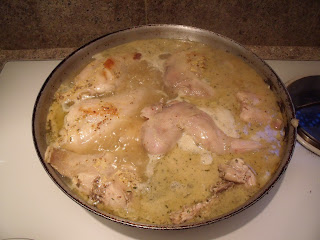Thursday, 24 November 2011, marked a Thanksgiving to remember at the Bothe household. The affair this year, which occurs annually on the final Thursday in the month of November, brought out not only the elite of the Upper Valley, but also hosted several VIPs hailing from Boston, London, Paris and Orleans. The evening kicked off with top entertainment as guests mingled and enjoyed savory delights, including a full-flavored Fougeru, Mediterranean green olives and pistachios, as well as popped corn garnished with rosemary-infused olive oil and sea salt.
 Dinner was an elaborate buffet presenting neo-classical Thanksgiving fare. Le piece de resistance was an 18-pound turkey, which was prepared and roasted in the following manner:
Dinner was an elaborate buffet presenting neo-classical Thanksgiving fare. Le piece de resistance was an 18-pound turkey, which was prepared and roasted in the following manner:The fresh turkey was removed from refrigeration about 1 hour before it was prepared, at which point the liver, neck and gizzard were removed. It was then given a gentle bath under cold running tap water and towel-dried before being rested on its back for a quick brush of butter and a seasoning of salt and pepper.
Next the bird was turned over, breast-side down, on an aluminum coated roasting rack set in a large roasting pan, and it was stuffed with a simple mirepoix of chopped carrots, celery, onion, lemon, and rosemary. Another brushing of butter and seasoning of salt and pepper left the bird ready for the oven, which had been preheated to a comfortable early roasting temperature of 425 degrees Fahrenheit.

One cup of water was added to the roasting pan in order to provide moisture for the cooking process, and the pan and bird were placed into the oven. It was 11:30 when the bird went into the oven, and by 12:30 it had finished its initial roast so it was removed from the oven ready for the next stage of preparation.
 This second stage commenced with the turkey being carefully turned over onto its back again with two pot holders- so as not to cause joint splitting to the bird or first-degree burns to the turner. The oven temperature was then reduced to 325 degrees Fahrenheit. The bird was returned to the oven and roasted for a further 2 hours until an instant-read thermometer inserted into the thickest part of the thigh read 170 degrees Fahrenheit. At this point the guests had not arrived, so the turkey was removed from the oven, and allowed to rest beneath a blanket of foil until it was ready to be carved.
This second stage commenced with the turkey being carefully turned over onto its back again with two pot holders- so as not to cause joint splitting to the bird or first-degree burns to the turner. The oven temperature was then reduced to 325 degrees Fahrenheit. The bird was returned to the oven and roasted for a further 2 hours until an instant-read thermometer inserted into the thickest part of the thigh read 170 degrees Fahrenheit. At this point the guests had not arrived, so the turkey was removed from the oven, and allowed to rest beneath a blanket of foil until it was ready to be carved.
The accoutrements to the turkey included house-made cranberry sauce and pan gravy, pommes de terre purees, Harvard beets, delicately spiced pearl onions, roasted Brussels sprouts, and of course a 100% house-made stuffing. The main portion of the dinner finished with a dressed autumn salad of kohlrabi, apple, carrot, dried cranberries, and walnuts. Although all the dishes were worthy of further explanation, for the sake of time, space, and convenience only the preparation method for the stuffing and gravy will be elaborated upon.
For the stuffing, a large loaf of home-made sourdough bread was chopped into one-inch cubes, and left to sit on an uncovered baking sheet over night. As the turkey was roasting the remaining components of the stuffing were prepared. First bacon was added to a hot pan and sauteed until it just began to turn crispy. Celery and onion were added and cooked until the onion turned translucent. This mixture was transferred to a bowl with the bread cubes, diced peeled and roasted chestnuts, and diced apple. Finally the turkey's liver was diced and flash-fried in a hot pan and added to the mixture.
The final step of the stuffing preparation was the adding of the liquid, which consisted of two whole large eggs, and 2 cups of freshly prepared turkey stock - this made for a less moist stuffing, but one that had lots of crisply toasted bread. The mixture was divided between two shallow baking dishes and baked for a total of 60 minutes.
 The preparation of the gravy began with simmering the neck and giblets of the turkey in about 4 cups of water with a bay leaf for about an hour. Once the turkey finished roasting and was sitting beneath its blanket of foil the roasting pan was set over high heat, and deglazed with a half cup of white wine. The deglazed drippings were then removed to a fat-separating gravy boat and the fat was poured into a large saucepan set over medium high heat. An equal quantity of flour was added to the fat then the deglazed liquid and the hot turkey stock were added a cup at a time and the gravy was left to simmer to a rich robust sauce.
The preparation of the gravy began with simmering the neck and giblets of the turkey in about 4 cups of water with a bay leaf for about an hour. Once the turkey finished roasting and was sitting beneath its blanket of foil the roasting pan was set over high heat, and deglazed with a half cup of white wine. The deglazed drippings were then removed to a fat-separating gravy boat and the fat was poured into a large saucepan set over medium high heat. An equal quantity of flour was added to the fat then the deglazed liquid and the hot turkey stock were added a cup at a time and the gravy was left to simmer to a rich robust sauce.


















































